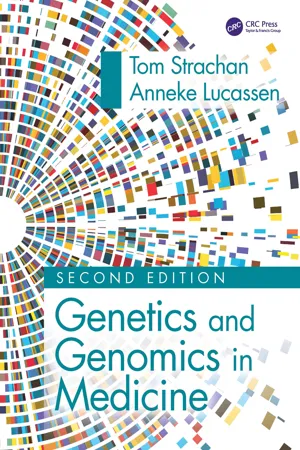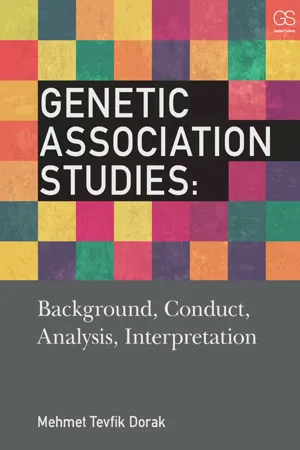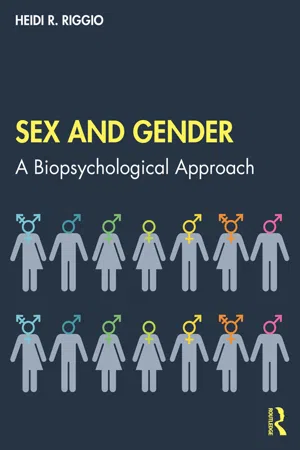Biological Sciences
X-linked Genes
X-linked genes are genes located on the X chromosome. In humans, males have one X and one Y chromosome, while females have two X chromosomes. As a result, X-linked genetic disorders are typically more common in males, as they only need to inherit one copy of the mutated gene. This inheritance pattern is known as X-linked inheritance.
Written by Perlego with AI-assistance
Related key terms
Related key terms
1 of 4
Related key terms
1 of 3
3 Key excerpts on "X-linked Genes"
- eBook - ePub
- Tom Strachan, Anneke Lucassen(Authors)
- 2022(Publication Date)
- CRC Press(Publisher)
hemizygous for such loci (because they normally only have one allele). Women normally have two alleles at each locus on the X chromosome.In humans any genetic character is likely to depend on the expression of a large number of genes and environmental factors. For some, however, a particular genotype at a single locus is the primary determinant, being both necessary and sufficient for the character to be expressed under normal circumstances. Such characters are often said to be Mendelian, but that implies that a chromosomal locus is involved; a more accurate term is monogenic (which takes into account both chromosomal loci and loci on mitochondrial DNA). Although collectively important, individual single-gene disorders are rare, and common genetic disorders depend on multiple genetic loci.When a human monogenic disorder (or trait) is determined by a nuclear gene, the disorder (or trait) is said to be dominant if it is manifested in the heterozygote (who carries a normal allele and a mutant allele), or recessive if it is not. Sometimes two different phenotypes that result from mutations at a single gene locus can be simultaneously displayed by the heterozygote and are said to be co-dominant. For example, the AB blood group is the result of co-dominant expression of the A and B blood group phenotypes that are determined by different alleles at the ABO blood group locus. As described below, the inheritance of mitochondrial DNA is rather different, with important implications for associated phenotypes.Various electronic resources provide extensive information on human single-gene disorders and characters (Box 5.1 ). GeneReviews® provides excellent summaries for many of the more common single-gene disorders that are accessible through the widely used PubMed system for electronic searching of biomedical research literature. We therefore often provide the eight-digit PubMed identifier (PMID) for relevant GeneReviews articles on single-gene disorders. The Online Mendelian Inheritance in Man (OMIM - eBook - ePub
Genetic Association Studies
Background, Conduct, Analysis, Interpretation
- Mehmet Tevfik Dorak(Author)
- 2016(Publication Date)
- Garland Science(Publisher)
parental effect and is discussed in a later section of this chapter.Only three of the 23 pairs of chromosomes (Chromosomes 21, 13, and 18) can be found in a trisomic state compatible with life. The reason for this is that these chromosomes are the ones with the fewest genes and they can be tolerated in a trisomic state. Fetuses with multiple copies of larger and more gene-dense chromosomes are lost before birth. There is nothing special about the genes on Chromosomes 21, 13, and 18 that cause certain syndromes when present in three copies. Likewise, disease genes are equally distributed in autosomal chromosomes and there is generally no preferential distribution of them on any particular chromosome. Possible exceptions are the high number of disease associations with HLA-region variants and the disproportionately high number of immune system-related genes in the X chromosome.Disease-causing mutations are also present in genes located on sex chromosomes
The human sex chromosomes are the X and Y chromosomes. The Y chromosome contains around 100 unique protein- and non-protein-coding genes that have no counterparts on the X chromosome, but there are no inherited disorders due to a mutation in a disease gene on the Y chromosome. Microdeletion of the azoospermia factor (AZF) region of the Y chromosome is common in oligospermia/azoospermia, and there are some suggestive studies for associations of Y chromosome variants with cardiovascular disease risk. It should be noted that the Y chromosome is about three times smaller than the X chromosome and a portion at both tips is shared by both chromosomes (Figure 2.1). These shared portions are called pseudoautosomal regions (PAR1 and PAR2) and act as autosomal genes. Approximately 95% of the Y chromosome is unique and is called the male-specific region. An important feature of this region is that it does not recombine, due to the lack of a corresponding chromosome with which to exchange material. This means that the Y chromosome is transmitted as invariant blocks from male to male. These blocks, consisting of specific variants, are called haplogroups (Figure 2.2 - eBook - ePub
Sex and Gender
A Biopsychological Approach
- Heidi R. Riggio(Author)
- 2020(Publication Date)
- Routledge(Publisher)
We have already defined some of these terms in Chapter 2 ; here, we will use slightly different definitions, to fit in the context of this chapter. Chromosomes are organized protein structures that contain genes; they are located within the nucleus of every cell. Human beings have 23 pairs of chromosomes, 23 inherited from their mother, 23 inherited from their father. The pairs of chromosomes are called homologous because they are similar in length, number of genes they carry, and gene location on the chromosome. A gene is a locus (or region) of DNA on a chromosome that encodes a cell function or protein product. Genes are the molecular units of heredity; they contain recipes for protein production within certain kinds of cells, proteins that affect human growth, appearance, functions of the body, and daily physiology. Because chromosomes occur in pairs, genes occur in pairs as well. An allele is an alternative form of a gene having the same position (locus) on a pair of chromosomes. Because we inherit one chromosome in each pair from each parent, we inherit different alleles of the same gene from each of our parents. Sometimes alleles are what is called dominant ; the existence of one allele always leads to the expression of trait, regardless of the other allele. In other words, possessing that allele affects a person’s phenotype, or the physical expression of a trait. Sometimes alleles are recessive ; multiple copies of the allele must be present for the trait to be expressed, for the phenotype to be affected. The particular combination of alleles one actually possesses is called a genotype ; the phenotype is how the genotype is physically expressed, either in appearance, in body function, in physiology, or in behavior. If a person possesses one of each type of allele (one dominant and one recessive), the person is said to be heterozygous for the trait, and the dominant trait will be expressed
Index pages curate the most relevant extracts from our library of academic textbooks. They’ve been created using an in-house natural language model (NLM), each adding context and meaning to key research topics.
Explore more topic indexes
Explore more topic indexes
1 of 6
Explore more topic indexes
1 of 4


